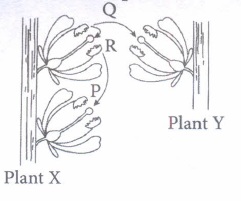In Class 12 Boards there will be Case studies and Passage Based Questions will be asked, So practice these types of questions. Study Rate is always there to help you. Free PDF Download of CBSE Class 12 Biology Chapter 2 Sexual Reproduction in Flowering Plants Case Study and Passage Based Questions with Answers were Prepared Based on the Latest Exam Pattern. Students can solve NCERT Case Study Questions Sexual Reproduction in Flowering Plants to know their preparation level.
In CBSE Class 12 Biology Paper, There will be a few questions based on case studies and passage-based as well. In that, a paragraph will be given, and then the MCQ questions based on it will be asked.
Sexual Reproduction in Flowering Plants Case Study Questions With Answers
Here, we have provided case-based/passage-based questions for Class 12 Biology Chapter 2 Sexual Reproduction in Flowering Plants
Case Study/Passage-Based Questions
Case Sudy 1: In angiosperms, the pollen grains are transferred from the anther to the stigma which is termed pollination. This phenomenon was first discovered by Camerarius (1694) at the end of the seventeenth century. Pollen grains are immobile. They cannot reach the stigma by themselves. An external agent is required for this. Pollination is mainly of two types-self pollination and cross-pollination.
The diagram given below shows two plants of the same species showing different types of pollination.
(i) What is transferred between the plants in the process indicated by arrow P?
| (a) Ova | (b) Pollen | (c) Nutrients | (d) Seeds |
Answer: (b) Pollen
(ii) Which of the following statements is correct regarding processes P, Q, and R?
(a) Processes P, Q, and R introduce genetic variability in the offspring of sexually reproducing plants X andY.
(b) Wind serves as an agent for process Q if plants X and Y belong to Genus Salvia.
(c) Flowers of plants X and Y need to produce odor and nectar for completion of processes P and Q if they-are entomophilous.
(d) If plants X and Y belong to Genus Cannabis, then their flowers need to produce sticky and heavy pollens in very small amounts for the accomplishment of process Q.
Answer: (c) Flowers of plants X and Y need to produce odor and nectar for completion of processes P and Q if they-are entomophilous.
(iii) Identify the processes P, Q, and R.
| P | Q | R |
| (a) Geitonogamy | Xenogamy | Autogamy |
| (b) Allogamy | Chasmogamy | Cleistogamy |
| (c) Autogamy | Geitonogamy | Xenogamy |
| (d) Geitonogamy | Allogamy | Autogamy |
Answer: (a)
(iv) In Catharanthus, the growth of style brings the stigma in contact with ripe anthers present on the mouth of corolla tube. This is an example of
| (a) homogamy | (b) cleistogamy | (c) geitonogamy | (d) xenogamy. |
Answer: (a) homogamy
(v) Which of the given processes represents a type of pollination that would result in greater adaptability of the particular species to potential environmental changes?
| (a) P | (b) Q | (c) R | (d) All of these |
Answer: (b) Q
Case Study 2: The endosperm makes the main source of food for the embryo. Generally, the endosperm nucleus divides after the division of the oospore, but in several cases, the endosperm is formed to a great extent even before the first division of the oospore. There are three general types of endosperm formation: (a) nuclear type, (b) cellular type, and (c) global type. The endosperm is usually triploid but haploid endosperm is also found. Endosperm may either be completely consumed by the developing embryo before seed maturation or it may persist in the mature seed.
(i) Haploid endosperm is found in
| (a) Pinus | (b) cauliflower | (c) sunflower | (d) pea |
Answer: (a) Pinus
(ii) Persistent endosperm is found in
P. Pea Q. Castor R. Bean S. Coconut T. Groundnut
| (a) Q and S | (b) P and T | (c) R, S and T | (d) P, S and T |
Answer: (a) Q and S
(iii) If an endosperm cell of a gymnosperm contains 12 chromosomes, the number of chromosomes in each cell of the root will be
| a) 4 | (b) 24 | (c) 16 | (d) 6 |
Answer: (b) 24
(iv) In angiosperms, normally after fertilization
| (a) the zygote divides earlier than the primary endosperm nucleus | (b) the primary endosperm nucleus divides earlier than the zygote | (c) both the zygote and primary endosperm nucleus divide simultaneously | (d) both the zygote and primary endosperm nucleus undergo a resting period. |
Answer: (b) the primary endosperm nucleus divides earlier than the zygote
Hope the information shed above regarding Case Study and Passage Based Questions for Class 12 Biology Chapter 2 Sexual Reproduction in Flowering Plants with Answers Pdf free download has been useful to an extent. If you have any other queries about CBSE Class 12 Biology Sexual Reproduction in Flowering Plants Case Study and Passage-Based Questions with Answers, feel free to comment below so that we can revert back to us at the earliest possible.
By Team Study Rate

